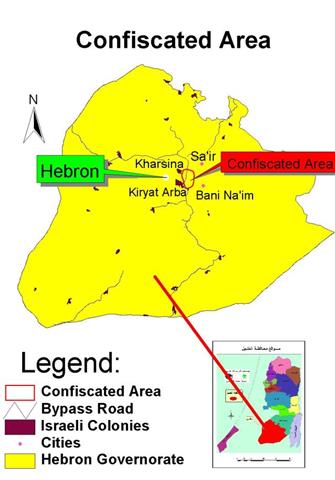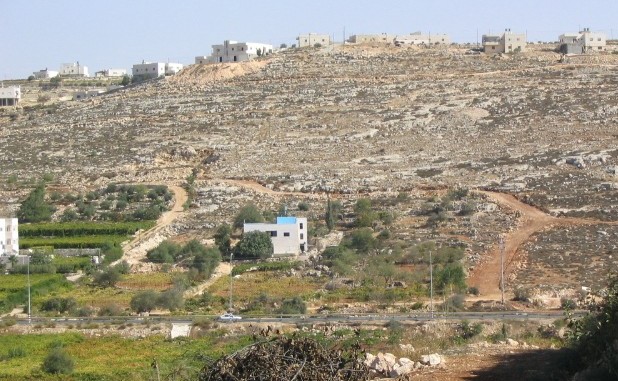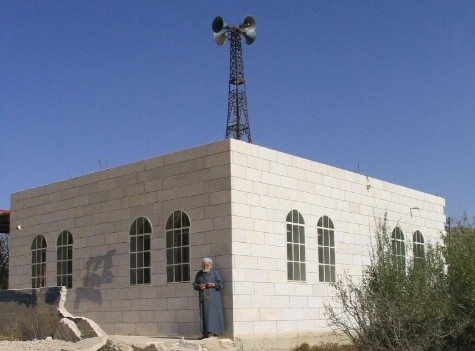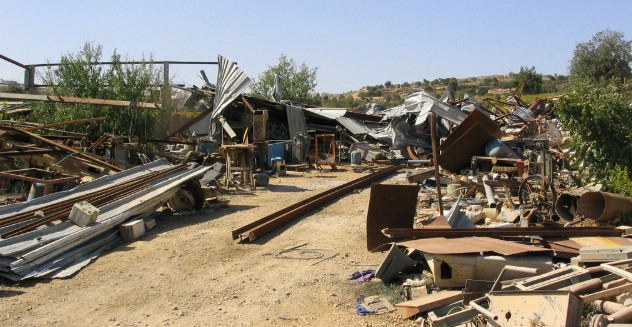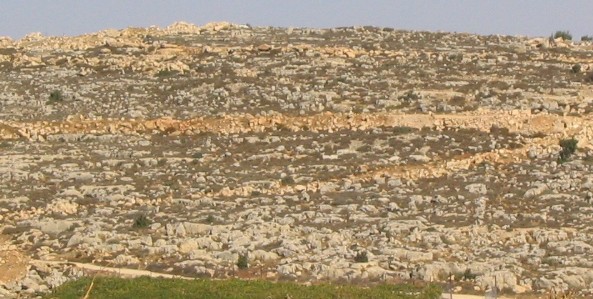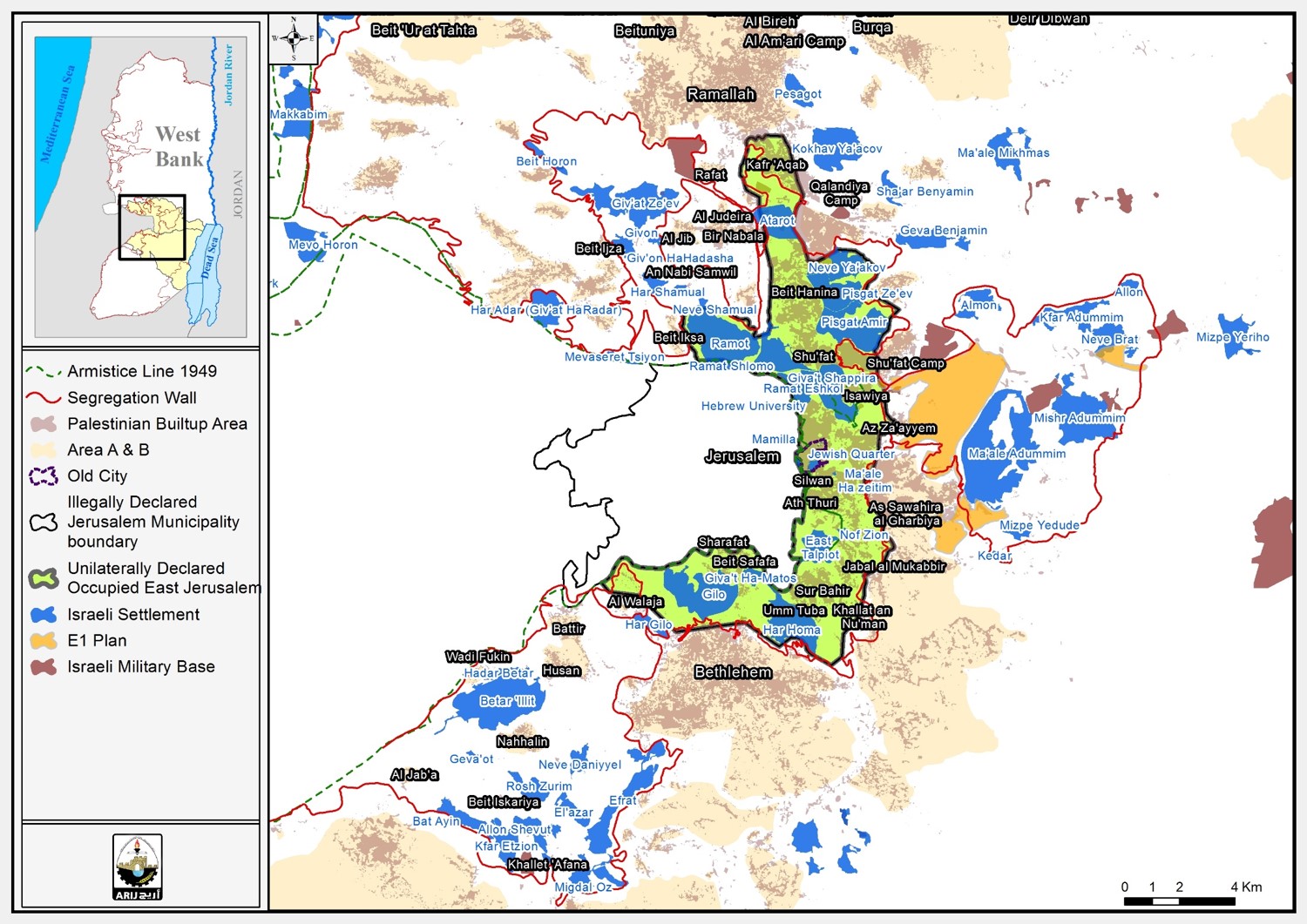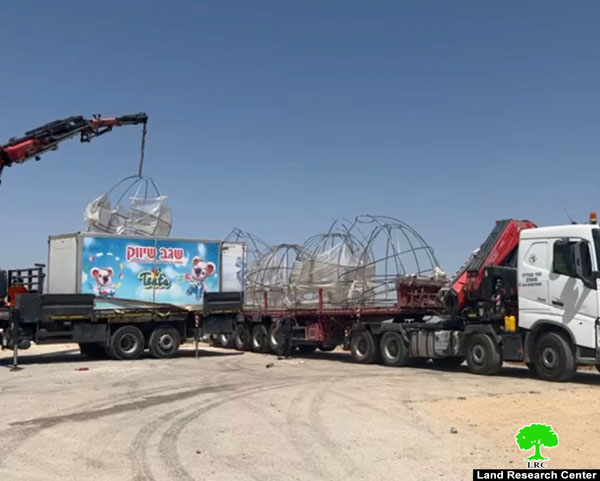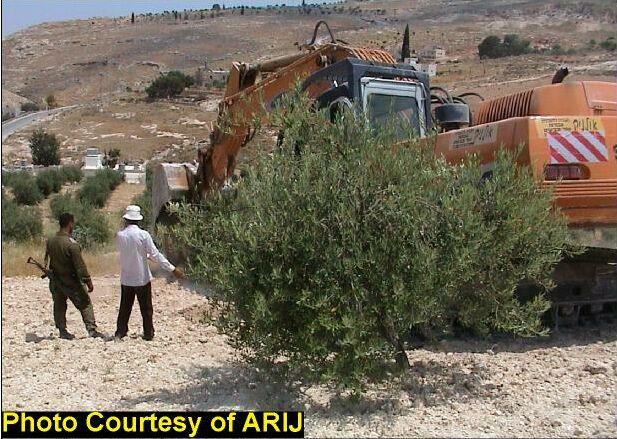Historical Background
One year after the Six-Days War in 1967, the Israeli government, as represented by the Gush Emonuim movement, put the cornerstone of the Settlement of Kiryat Arba to become the center of Jewish extremists craving to occupy the Ibrahimi Mosque and the Old City of Hebron. Throughout the years the expansion of the Settlement never ceased to the degree that a new neighborhood, called Kharsina, was established to the north of the main Settlement. The area separating between the two settlements included a vast area of Palestinian lands and houses. At this point in time, the number of Jewish settlers living in these two Settlements has reached up to 6,400, most of which can be termed ultra extremists. It is worth noting that Dr. Baruch Goldestien, who committed the Ibrahimi Mosque massacre on the 25th of Ramadan 1994, was a member of the Kiryat Arba' settlement. Moreover, these two settlements are considered to be among the largest in the West Bank as they include an industrial zone.
Latest Colonial Expansion
Israeli occupation authorities, along with the extremist settlers, confiscated vast areas of land in Winter of 2001. They have done so through establishing a sandy road around and inside the mentioned lands, which are located to the north, east and south of the two settlements. See Map
The confiscated lands are divided into two sections:
The first section: is located to the east of Road 60 and consists form a chain of hills that starts at Al Mugheer Valley (between Bani Nu'eim and Hebron city) and ends at Ras Abu Riesh (the beginning of the road leading to the town of Sair). The total area of lands in this section is about 2000 dunums owned by more than 50 Palestinian families.
The initial actions to confiscate the land started in two time intervals: The first was in winter of 2001 when a number of Israeli large hammers and bulldozers opened up sandy roads around and inside the southern section of the above mentioned land. The second time interval was in winter of 2002 when Israeli large hammers and bulldozers, under heavy IOF protection, opened roads and corridors in the northern parts of the land.
In an interview conducted by Land Research Center (LRC)'s field researcher with a number of the owners of the confiscated lands, they stated that the Israeli occupation forces claimed that the confiscated lands are 'Israeli State Lands' that was deemed expropriated in 1982 and that a grace period for objection was given to the owners at that time. The owners stated that they have never seen such orders and have no knowledge of their existence. Moreover, when the owners objected to the actions carried out in 200, they were told to go to Bet Eil.
It is worth mentioning that a number of Palestinian houses are located within the expropriated lands. The owners of these houses, who actually live in it along with their families, do not know what the future is holding for them, especially that some of the established roads run very close to their houses and backyards. What makes things worse is the existence of some 400 dunums planted with olive trees whose owners are not allowed to access, cultivate or even to collect the crops due to the constant presence of army and Settlement guards. See Photo 1 & Photo 2 &
A hill top in Al Oddeisah area at the eastern bank of road 60 crossed by sandy roads surrounding Palestinian houses
Another hill top in Al Duwarah area crossed by sandy roads surrounding Palestinian houses
Photo taken by LRC field worker
Following, is a list of some owners whose lands were expropriated in Al Oddeisah and Al Duwarah regions affiliated to Sa'ir village, and Wadi An Nasarah affiliated to Hebron city:
|
Number |
Names of owners |
Area in Dunums |
|
1 |
Heirs of Mr. Abdel Qader Orman |
40 |
|
2 |
Heirs of Mr. Abdel Rahman Buhais |
20 |
|
3 |
Heirs of Mr. Abdel Muhsain Buhais |
40 |
|
4 |
Heirs of Mr. Younis Isma'eel Jaradat |
25 |
|
5 |
Heirs of Mr. Shaeen Isma'eel Jaradat |
25 |
|
6 |
Heirs of Mr. Yousef Isma'eel Jaradat |
60 |
|
7 |
Mr. Musa Shaker Jaradat |
35 |
|
8 |
Mr. Mohammad Shaker Jaradat |
35 |
|
9 |
Heirs of Mr. Mohammad Da'adoosh |
80 |
|
10 |
Mr. Ahmad Sa'ed Jaber |
30 |
|
11 |
Mr. Saleh Abu Odeh Jaber |
30 |
|
12 |
Mr. Abdel Jawad Dalash Jaber |
15 |
|
13 |
Mr. Bader Dalash Jaber |
15 |
|
14 |
Mr. Mahmoud Shukri Jaber |
20 |
|
15 |
Mr. Abdel Hadi Tawfeeq Jaber |
20 |
|
16 |
Mr. Tayseer Abdel Shakoor Jaber |
10 |
|
17 |
Heirs of Mr. Husni Al Ash'hab |
20 |
|
18 |
Mr. Abdel Hameed Yehya Al M'toor |
40 |
|
19 |
Mr. Shaker Hamed and his brother Ibraheem Hamed |
60 |
|
20 |
Mr. Abdel Jaleel Abdel Muhtadi Al M'toor. |
30 |
|
21 |
Heirs of Mr. Abdel Raheem Al M'tour |
20 |
|
22 |
Mr. Fadel Jaber |
10 |
|
23 |
Heirs of Mr. Mohammad Orman |
10 |
|
TOTAL |
690 |
|
The second section: Is located to the west of Bypass Road 60. It starts from the northern outskirts of the Settlement of Kharsina and ends at the Beit Einoun crossroad. Such lands are located in the areas of Al Baqa'a, Khillat Al Natsh, Al Bweira, Khillat Al Dabae', Khillat Al Sanasel, Al Kharjah, in addition to Wadi Al Ghrous.
The total area of the confiscated lands in this section is estimated to be 1,000 dunums owned by the families of Sultan, Jaber, Al Ash'hab, Al Natsheh, Talhami and Abu Karsh. The last confiscation took place on the 9th of October, 2003, in the regions of Al Baqa'a and Al Bweira when an officer from the 'The Civil Administration' submitted military order number T/39/2003 to the owners of the lands. The orders informed the affected families that Israeli forces were impounding 67 dunums of their lands. The officer informed the owners that the goal of the confiscation was to build a security zone around the Settlement of Kharsina. He, also, claimed that the owners could later access their land for agricultural goals but only after getting Israeli-issued permissions. The owners were given only 10 days to object to the confiscation decision which is not an enough period of time to pursue the legal procedures. It is worth mentioning here that prior to the release of this military order, settlers from the two settlements had created facts on the ground by encircling the targeted lands with barb wires, creating inland roads and preventing the owners from accessing the land. See Photo 3
The Settlement of Kharsina – northeast Hebron: a number of hill tops in Al Bweira encircled by sandy roads in preparation for confiscation and annexation
Continuous Harassment and Suffering
Palestinian residents living near the Settlement of Kharsina are being faced with death, expulsion and land confiscation on daily basis due to the presence of the Settlement and the soldiers who guard it. They are faced with one of two difficult options: either to stay in their houses and face continuous suffering or pack up and leave. All of the residents chose the first option without any hesitation.
Most of the residents around the Settlement of Kharsina are from one extended family. They inherited the land from their fathers and grandfathers and still live and work the land. Mr. Isma'eel Sultan, a 30-year old, married, and lives with his family by the Settlement of Kharsina, described the tragic situation there, as settlers' attacks are non-stop and increases in frequency whenever a Palestinian attack against the Settlement takes place. Mr. Sultan, whose house is located only 300-meters away from the fence of the Settlement, stated that to LRC's field worker the following:
'We live in a tragic situation as settlers' attacks are non-stop and can happen at any given time. My family lives in a constant fear, especially the children who have to go through the military checkpoint located at the entrance of the Settlement every time they go to school. After sunset, nobody is allowed to go out of his house or to visit his neighbors or else he would be risking being caught and beating by Israeli soldiers. We are allowed to move freely only during the day. If one of us finished his work late, he would be obliged to sleep somewhere else outside of the region. Moreover, when the situation becomes a bit tense due to Palestinian paramilitary activities against Israeli soldiers or settlers in Hebron, a strict curfew is usually enforced upon us as we would not be allowed to go outside of our houses either during the day or during the night. That is due to the existence of a military tower located between our house and the Settlement which allows the soldiers to notice every move we make. Sometimes students by-pass the Israeli checkpoint by going through the fields to get to their schools as to spare themselves needless humiliation, especially that Israeli soldiers and settlers usually walk around accompanied by large dogs. Last year when one of the settlers got killed, hundreds of settlers attacked a number of houses breaking b the windows, uprooting trees, burning down some houses and destroying its contents, torching cars, impounding some cars and breaking the windows of others.' See Photo 4
Settlement houses advances towards Palestinian houses north east of Kharsina
Photo taken by LRC field worker
The road of horror- Palestinian pupils walking by the Settlement fence on their way to schools
Photo taken by LRC field worker
The settler 'Nati' Occupies a hilltop, Harasses Palestinians Before Being Killed
Five years ago a settler from the Settlement of Kharsina, called Nati, occupied a hilltop located next to a Palestinian community in the region of Al Bweira under the protection of Israeli soldiers and policemen. Later, Nati established a sheep and goat pen which he used to let them go free to eat of off Palestinian grape fields causing, in the process, a great deal of damage to Palestinian crops. Moreover, he used to travel through a road that he, with the help of other settlers, established on Palestinian lands in Al Bweira region. The road is one-and-a-half kilometers long with a width of 6 meters. It has been the case that Palestinians were harassed countless times by Nati and other settlers using this road. A year ago, unknowns killed Nati.
Collective Punishment – A Wide Scale Attack on Palestinians.
In an interview with Sheikh Abdel Rahman Sultan, 90-years old, one of the residents of Al Bweira and the Imam of the mosque there said that after the death of Nati thousands of settlers attacked and raided about 20 Palestinian homes in the area and carried out the following attacks:
-
Attacking Sheikh Sultan furiously until a military jeep came in and carried him to an Israeli ambulance which, in turn, transferred him to the nearest Palestinian point. A Palestinian ambulance, then, transferred him to Al Ahli Hospital in Hebron where he stayed for three days before being able to go back to his home.
-
Smashing the windows of the mosque as well as demolishing part of the wall surrounding it.
-
Smashing the windows of all the houses in Al Bweira region as well as destroying its content and mixing food items together.
-
Burning down a house owned by one of the sons of Sheikh Sultan.
-
Torching 6 cars and breaking the windows of an unknown number of other cars.
-
Stealing 3 to 4 tons of grapes.
-
Uprooting olive seedlings planted by Al Ash'hab family in the prior season on a 10-dunum piece of land. In the second half of October 2003, the settlers came back and plowed the land to ensure their intention to annex the land into the Settlement.
-
Demolishing a 120-squre meter house under the pretext that it was built without proper permits.
-
Demolishing a car repair workshop owned by Mr. Abbas Abdullah Sultan.
-
Destroying a 1000 M2 chicken farm owned by Dr. Sufian Sultan.
-
Threatening to demolish a 2000 M3 pool for water harvesting owned by Dr. Sufian Sultan.
-
Bulldozing 6 dunums filled with grapevines and citrus trees. This land was owned by both Zuhdi and Sufian Sultan.
-
Cutting off the line that supplies Al Bweira with water. Until now, the line is still cutoff and Palestinians in the region depend nowadays on water collected in wells.
-
Arresting a number of men for interrogation in connection with the Nati case. They were later released as no connection between them and the incident was established.
-
Preventing Palestinian cars from reaching Hebron through the gate of the Settlement of Kharsina which forced the Palestinians to carry their groceries and the like and walk a distance of two kilometers to reach their homes. See Photo 6, Photo 7 & Photo 8, &
The mosque walls were destroyed & windows smashed by Kharsina settlers
Car repair shop for Mr. Abbas Sultan was demolished by Kharsina settlers, Hebron

The pool of Dr. Sufian Sultan threatened with demolition
Photo taken by LRC field worker
Rescue Attempt
In a step to prevent the expropriation of the land on the top of Al Bweira hill, an area of 72-dunums, land owners sold their lands to the Palestinian Teacher's Society. The sale took place 5 years ago with minimal price. The goal was for the Society to build housing units for its members to prevent the land from being annexed into the Settlement of Kharsina and to increase Palestinian presence in that region. Yet, Israeli authorities prevented the Society from acquiring the proper permits needed for the building to proceed which was an initial step to allow the confiscation of the land.
That was exactly what took place two years ago when settler bulldozers and hammers erected a sandy road around the land in an initial step to confiscate it and annex it into the Settlement. As a reaction, the owners of the land accompanied the Society to the court in Biet Eil with all ownership documents that dates as far back as the Ottoman Empire ( Taboo). The court refused to look into the matter which led the Society to petition the Israeli High Court. As of today, legal deliberations are still taking place and no decision has been handed down. See Photo 9
Another hill top in Al Bweira where many roads were opened prior for confiscation
Photo taken by LRC field worker
An Israeli Luring Attempt Faced by Palestinian Rejection
Sheikh Abdel Rahman stated that an officer in the so-called Israeli Civil Administration asked about two years ago the Palestinian residents of the area to accept being offered services from the Kiryat Arba municipality instead of the Hebron municipality. The residents refused such an offer due to their prior knowledge that this offer is nothing but a ploy designed to trick them out of their lands which would be expropriated after any incident affecting the 'security' of Israelis living in Kiryat Arba and Kharsina settlements.
The Lands of My Fathers and Forefathers
Sheikh Abdel Rahamn, who holds a PhD in Islamic Law from Al Azhar University in Egypt, said the following during an interview with LRC's field researcher: 'This land is the land of my father and forefathers. I was born here and lived with my father and grandfather along with my siblings. It used to take us only 5 minutes by car to reach the old market in the center of Hebron city. That was before the establishment of the settlements which separated us from the city and the Ibrahimi Mosque in which I used to pray on daily basis. Now, it is very hard to reach the Haram or the city. We have to use alternative roads which mean spending longer periods of time to reach our destination. Not having settlers' attacks does not making our lives that much easier as the suffering continues as cars are not allowed to reach our houses. So, we ended up buying a donkey to transport goods through the 2 kilometer long road from the military checkpoint at the entrance to Kharsina until our homes''.
Prepared by
The Land Research Center – Jerusalem
LRC


